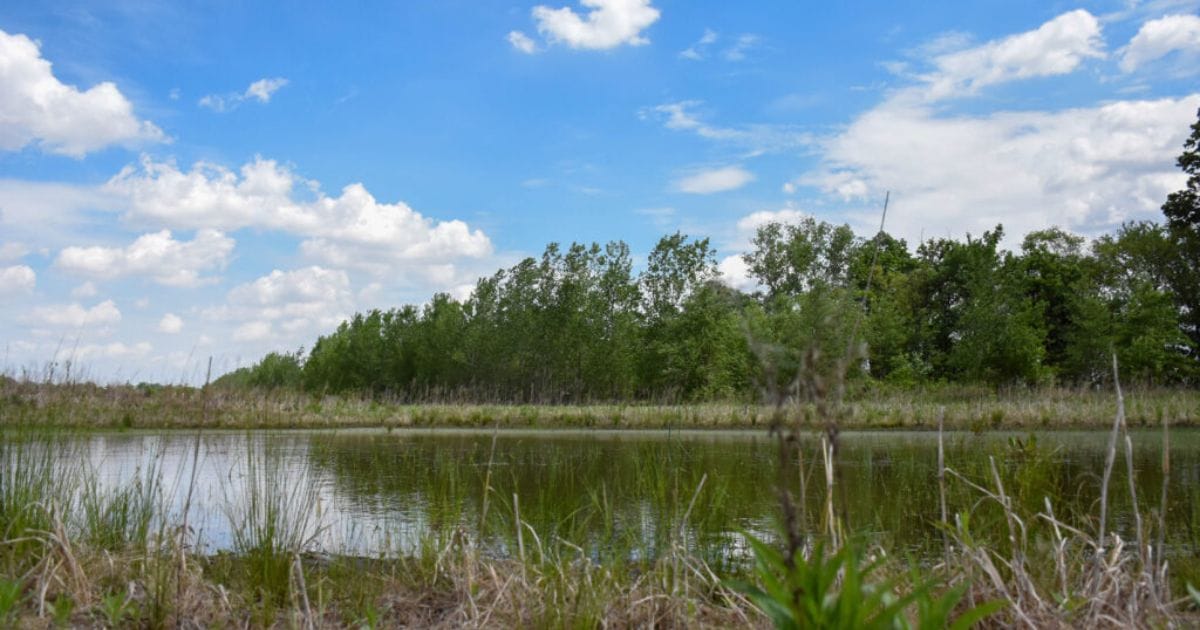Photo caption: Multiple lawmakers on the Indiana Drainage Task Force expressed concerns on Wednesday, Oct. 11, 2023, about the accuracy of the state’s floodplain maps and said they now support a more robust system that ensures property owners know if they are in a flood zone. (U.S. Department of Agriculture Natural Resources Conservation Service/Flickr)
The Drainage Task Force is seeking to improve how landowners are notified and involved in mapping changes.
Are enough Hoosiers up to date on statewide floodplain mapping? How are landowners being notified about changes to those maps? And should property owners have more say, overall, in what areas are designated as flood zones?
Those questions were at the heart of the Indiana Drainage Task Force’s Wednesday meeting, where lawmakers, state officials and industry experts gathered to discuss the ability of landowners to seek changes in flood hazard map designations after the Indiana Department of Natural Resource’s (DNR) “best available mapping data” is adopted by the federal government.
Talks also centered around the possible effects of the DNR’s “best available mapping data” on mortgage lending, as well as the need for — and availability of — flood insurance.
Hoosier property owners continue to complain that the newest floodplain maps adopted by the DNR are more restrictive than those from the Federal Emergency Management Agency (FEMA). Many contend that they were never notified of the floodplain map changes that went into effect in 2022 and are now faced with costly requirements for building projects on their property.
Multiple lawmakers expressed concerns on Wednesday about the accuracy of the DNR maps and said they now support a more robust system that ensures property owners know if they are in a flood zone, whether it be within the state or federal maps.

They emphasized, too, that a process should exist for Hoosiers to challenge the mapping in a timely manner — without exorbitant costs.
“I think these (DNR) maps aren’t ready,” said Republican Rep. David Abbott, of Rome City. “I think we need to take a step back — a big step back — take a look at these maps as a whole, and take them off the table. I think these maps need to be avoided temporarily until they can go in and do a more detailed modeling … of the whole state. And that’s going to be very, very expensive.”
Environmental groups, meanwhile, point to increases in extreme rain events that lead to greater flooding. They maintain that state lawmakers should focus more on ways to introduce green infrastructure — like planting trees and restoring and protecting wetlands.
The interim committee, created in 2022, is tasked with reviewing state drainage laws and making recommendations concerning drainage and regulatory matters — including at the legislative level. Wednesday’s meeting was the second of three to be held this fall.
Concerns over proper notification
A floodplain is the area next to a stream or river that is at risk for flooding at least once per 100 years or more.
Resulting floodplain maps are often made by calculating rainfall, topography, and hydraulic analysis, which evaluates the capacity of a stream or other water body.
FEMA has published maps for many of Indiana’s floodplains, but not for all of them.
To cover the rest of the state, the DNR maintains floodplain maps for an additional 18,500 miles of Indiana streams. The state agency combined its maps with those created by FEMA to produce the Best Available Flood Hazard Area map.
Environmental advocates maintain that the DNR map is the best resource for identifying flood-prone areas. Currently, local floodplain administrators are charged with using it to reduce construction in the floodplain so rivers and streams can spread out, as needed. That keeps flood waters from flowing as fast or rising as high, which also reduces erosion.

But several on the Drainage Task Force took issue with the lack of notification given to property owners about changes to the DNR floodplain maps. Updates to the state maps meant some parcels of land were no longer determined to be in flood zones, while others are now located in newly-designated floodplains.
DNR water division director David Knipe maintained that the agency’s new maps have been available online since 2018. It has been up to Hoosiers to access that data on their own.
Now, however, FEMA is in the process of updating federal maps, beginning with Wells County. New map adoptions are expected in other Indiana counties in the coming years.
As a part of that process, a public hearing is held when maps change. If property owners don’t like the maps proposed, they can hire a surveyor or engineer to refute them, although industry representatives said Wednesday that appeal could cost Hoosiers upwards of $20,000.
Knipe said about 2,000 fliers were sent out about the informational meeting to Wells County property owners affected by floodplain designation changes, but that only 50 people showed up.
Abbott said the filers amounted to “mumbo jumbo” for many who received them: “They’re not going to understand that their designation has now changed.”
“Maybe we need to extend the time period where these people have a chance to respond and have their properties checked,” he added. “Whether we disregard the maps or we delay the maps, I don’t think FEMA should be coming in adopting them yet.”
Sen Jeff Raatz, R-Richmond, said property owners should be informed about the latest changes and have a chance to refute the maps before DNR sends them to the federal government.

“I’m protecting the property owner. I shouldn’t have to pay to go to the federal government after the fact and … defend my supposition that I’m not in the flood zone,” he said, maintaining that while “maybe 90% to 95%” of DNR’s maps are “absolutely accurate,” some are still in contention and deserve to be refuted. “I don’t think it’s the role of government to just all of a sudden say, from the top down, that you’re now in the floodplain without having any conversation with people who rightfully own that property.”
Task force co-chair Sen. Jean Leising, R-Oldenburg, agreed that the DNR fliers didn’t do enough to properly notify affected Hoosiers in Wells County. She said she’s concerned that, unless changes are made, thousands of Hoosiers will remain under-informed.
“I think the flier obviously wasn’t as effective as it needed to be because otherwise more than 50 people would have come if they would have understood the ramifications of what it might mean to their property values and for their ability to build,” she said at Wednesday’s meeting. “I think it’s wrong that we have taken away people’s property rights without any of them knowing it.”
Insurance matters and implications
Knipe said there are more than 2.5 million households in Indiana, but only 17,390 flood insurance policies in effect. Most, but not all, are actually located within a floodplain.
Any property owner in a community that participates in the National Flood Insurance Program (NFIP), no matter what floodplain they are in, can purchase flood insurance. Not every Hoosier community takes part in the program, but the majority do, he said.
Ross Teare with the Indiana Bankers Association said his industry “relies solely on FEMA floodplain maps, rather than DNR mapping,” because that’s all that is required by federal law when determining whether flood insurance is needed.
He said FEMA maps enable banks to establish whether a property falls within a designated flood zone. When it does, federal regulation mandates that the property owner maintain flood insurance. Banks are responsible for ensuring that borrowers adhere to the requirements when they provide loans.
A lender is required to notify property owners at least 10 days ahead of closing, but many banks alert clients as soon as the purchasing process begins, Teare said.

If maps are updated, like in Wells County, banks are required by federal law to notify property owners that they are now in a floodplain zone and are required to have floodplain insurance, Teare added.
“We just want the most accurate maps available because our interests need to be protected when it comes to mortgages, and we need to know where the floodplains are,” he said before the task force.
Wayne Capek, president and CEO of Brownsburg-based Floodplain Consultants, which represents about 60% of the banks in Indiana, said nearly all lenders use services like his to track floodplain map changes.
Floodplain Consultants is already keeping tabs on 1.2 million properties. If a FEMA map change goes into effect, Capek said his company will notify lenders within 30 to 60 days that the property is now in a special flood hazard area and flood insurance is required.
Capek said flood insurance costs a Hoosier property owner, on average, anywhere from $500 to $1,000 annually through the federal insurance program, but varies depending on the property.
Michael Niland with the Insurance Institute of Indiana further said there is a private market for homeowners seeking flood insurance, but that can be even more expensive.
Other task force issues
Raatz recommended that any future changes to floodplains in Indiana would require meetings at the county level, with all affected individuals, “to make sure there are no errors.”
“The issue for me is not that things are either in the floodplain, it’s the process … and how we notify property owners,” he said.
Knipe said the DNR is “not adverse” to a beefed up notification process about future changes to the best available floodplain maps, but he cautioned that more requirements can become “quite a burden” for agency staff.
“I mean, do we knock on people’s doors and tell them they’re in a floodplain?” he asked.
Rep. John L. Bartlett, D-Indianapolis, additionally echoed others who suggested that information about floodplain mapping should be sent out with property tax bills.
Jeff Healey, a supervisor for the Hendricks County Soil and Water Conservation District and member of the task force, said DNR mapping should be “ground truth” to make sure that the previous surveying has accurately reflected the ground surfaces. Doing so would require boots on the ground, which Knipe said the agency “certainly doesn’t have enough staff for.”
Nearly two dozen other recommendations have also been submitted by task force members, so far. That includes proposals related to permitting, ditch mapping, updates to the state’s drainage handbook and jurisdictional responsibility changes for the DNR and Indiana Department of Environmental Management.
The task force must make final recommendations by the end of the month.
Ahead of the 2024 legislative session, the committee was tasked with reviewing the responsibilities of landowners and state and local authorities under newly enacted Indiana legislation and recent U.S. Supreme Court decisions.
Members are also seeking to determine:
- whether authority over drainage matters is shifting from county drainage boards to state authorities
- the extent to which the state’s drainage laws align with conservation and pollution control objectives
- whether the delays and costs associated with regulatory requirements applying to farm conservation projects are too great
- whether floodway permit requirements should apply to the installation of fences and the removal of embedded tree limbs and stumps on farmland located in floodways
- whether the balance between state authority and local authority over drainage of agricultural land favors state authority more in Indiana than in neighboring states
The committee consists of 19 members, including six members of the Indiana Senate, six members of the Indiana House of Representatives and seven governor-appointed individuals.
During the task force’s last meeting, in September, members largely focused on breaking down Senate Enrolled Act 242, which passed during the 2023 session and changed how Indiana’s floodplains are mapped.
The legislation nixed a provision in state law that required floodplain administrators to use the “best floodplain mapping data available” when reviewing an application for a construction permit in or near a floodplain.
It also allows a property owner to request a review by the DNR of the mapping data that applies to their property. Agency officials said the agency will complete the review and data analysis in 120 days at no cost to the requestor.
SEA 242 further requires the floodplain administrator of a county or municipality to complete certain training by June 30, 2025. There are currently 310 administrators throughout the state, according to DNR officials. The agency has already contacted those individuals via email and mailed letters about the new requirement.
Sellers are additionally required to disclose whether a property is located within the FEMA floodplain maps.
This article originally appeared on Indiana Capital Chronicle.






